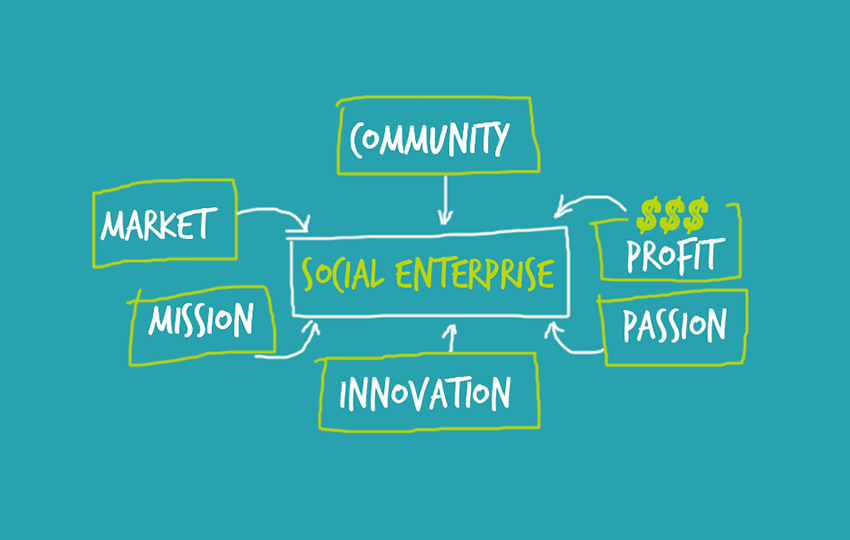Business for Good, Part 2: Social Enterprises
Last month, we wrote about the business structure of B-Corporations (Benefit Corporations), also known as a B-Corp. B-Corps are businesses that go through a voluntary certification process to ensure that the company not only maintains a healthy bottom line, but is also responsive to the community and the environment in which it operates.
Craig Olson of our Small Business team notes that through his experience of running various nonprofits in the past, he knew about B-Corps, but he hadn’t heard much about social enterprises until recently. “I attended a conference earlier this year in Scotland where we went through a quick, deep dive into the structure and benefits of social enterprises. As a business owner, it was inspiring to me, and I thought that others could benefit from learning about this as well.”
What is a Social Enterprise?
Simply put, a social enterprise is an organization that puts its social goal first and its profit goal second.
This isn’t to say that the goal isn’t still to make a profit, but it’s to make a profit in a meaningful way that contributes to the organization’s mission and doesn’t pursue projects for profit that don’t align with its social goals.
There are very few social enterprises in the United States. Why is that? The answer is money, or more specifically, taxes. The U.S. tax system is structured to encourage citizens to donate to established nonprofits and receive a benefit of a deduction on their annual taxes. Social enterprises exist mainly in countries with a very different system of charities, differing levels of government involvement, and funding via their tax structure in areas like health care and higher education.
Examples of Social Enterprises
By providing a structure somewhat between for-profit and nonprofit, the social enterprise allows a more entrepreneurial approach to meeting social mission goals. A social enterprise doesn’t have to be a nonprofit, but it has mission-driven goals similar to a nonprofit. Here in the United States, Goodwill Industries would be an example, as well as your local credit union.
In talking with a colleague from the Orkney Islands in Scotland, we learned that on one island there was no longer a community gathering spot that would be open 5-6 days per week. A social enterprise was formed to open a café, which evolved into a café and pub that has now become a community hub. The goal was to create a community gathering place, running it like a business, but with the excess profits returning to the parent social enterprise to fund additional projects like a storage unit business.
So, in a social enterprise, customers can support a business that benefits the community on a higher level, creates jobs, and contributes to the tax base of the community. The same has been done with housing, daycare facilities, and taxi services.
Possibilities for Maine’s Island and Coastal Communities:
The Tom Glenn Community Impact Fund
While we don’t mean to suggest what type of business should be a social enterprise or which of these practices nonprofits can use to help fulfill a social need, it did get us thinking about possibilities here in the United States, and specifically, along the coast of Maine.
Last month, the Island Institute launched our new Tom Glenn Community Impact Fund. In addition to pulling different infrastructure and planning grant funds, loans, and equity investments together under one central fund, it will also allow us to look holistically at how we can serve our social mission of helping to build sustainability in island and coastal communities. Not only can the Glenn Fund help communities in need, but it can also help start businesses or even add leverage to an existing business.
In order to do the most good, over time, the Fund will need to grow, and it is important to recapture investments when we can. That is certainly our aim with loans and equity investments, but what about grants? If the Glenn Fund finances a grant that leverages additional funding, would it be too much to ask to have that grant repaid? The grantee would, in effect, be paying it forward for other communities to have the same opportunity, and the fund would continue to grow.
Our hope is that if you’re reading this and thinking about a business startup, you’ll take time to ask the following: Is there a need in my community that is not being met? Is there a viable business in that idea? If so, does it meet a social need in your community?
If you live on an island, you know that nothing exists in a vacuum. Would you be willing to create a business that supports and sustains you, but also does the same for the community in which everyone is your neighbor? Let us know your thoughts!
Interested in Learning More?
Feel free to reach out to Craig Olson or Claire Donnelly if you’re interested in chatting more about how to drive your business forward with a social mission, or have questions about financing options through the Tom Glenn Community Impact Fund.
Featured Resources
- What is Social Enterprise
- Social Enterprise Alliance
- Highlands and Islands Enterprise (Scotland)
- Tom Glenn Community Impact Fund
Further questions?
Contact Craig Olson or Claire Donnelly with the Small Business team.
What We Do
The Island Institute’s Small Business Team provides business and financial planning to help entrepreneurs navigate the complexities of starting and growing a business. For more information on our small business support services, feel free to contact Craig Olson.
Commercial Currents is an email and blog newsletter that shares buoyant stories from Maine’s island and coastal communities about economic stability and resilience. To find archived editions, go to islandinstitute.org/blog/economic.
Know someone who’d enjoy these emails? Subscribe here.


